The sol-gel chemistry comprises chemical reactions involving colloidal particles in a sol, or between alkoxide-precursors and water, in a solution, leading to a highly porous amorphous gel product, in which a liquid phase (solvent, catalyst and eventually excess reactants) may be retained in products. The sol-gel SiO2 NPs synthesis comprises different methodologies, namely colloidal route and solution route (base- or acid catalyzed).

Silica and titania dense, hollow-sphere, and core-shell NPs (monosized, with diameters from 30 nm up to 500 nm) have been synthesized by classical Stöber and LaMer methodologies (base catalyzed, solution route), aiming pharmaceutical and medical applications. New synthesis protocols were developed.


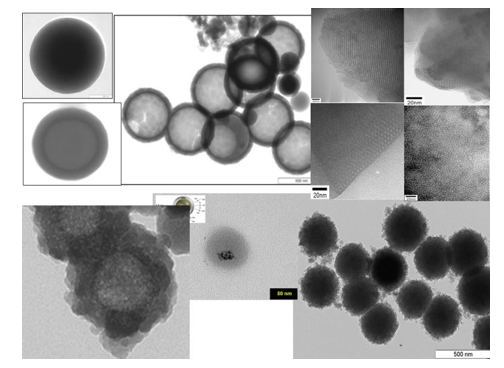
As a nanocarrier, silica competes with biological materials (like phospholipids, lipids, lactic acid, sugars, proteins such as dextran or chitosan, virus), synthetic polymers (carbon or silicon- based), and other inorganic materials (ceramics, metals).

Silica’s high thermal stability, chemical inertia (at PTN conditions), microbial attack immunity, along with strong surface energy, high hydrophilicity and biocompatibility, impermeability (or weak permeability), great chemical versatility (due to the possibility of in situ/ex situ physical functionalization, through second order chemical bonding, or chemical functionalization, in highly specific conditions), high loading capacity for drugs/chemicals/therapeutic molecules, a prolonged blood circulation time, associated with ease of processing are the properties that made silica an excellent candidate for a wide range of biomedical and pharmaceutical applications, namely, gene or drug delivery, different imaging modalities like fluorescence or actively targeted nanoprobes. In situ silica functionalization, by introducing organic functional groups during the sol-gel process (forming an ORganically MOdified SILica matrix, known as ORMOSIL), allows easy chemical conjugation/decoration of biomolecules at the ORMOSIL surface and/or the load with either hydrophilic or hydrophobic drugs/dyes.
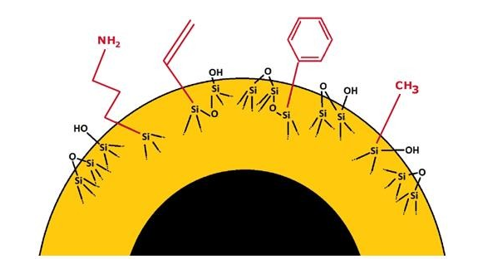
Among the commonly used functionalizing groups, amine (-NH2) is the one promoting more efficient pDNA interactions, easily tested by agarose electrophorese.
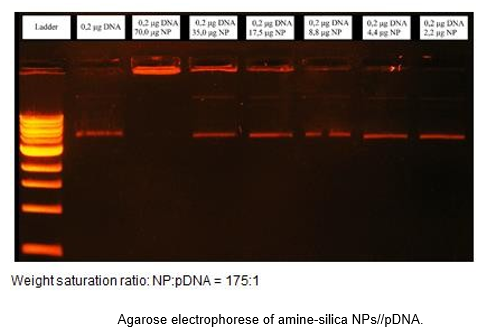
The bio-conjugation between NH2-silica NPs and pDNA takes place by electrostatic bonding between the cationic -NH2 group (present in the hybrid silica NPs) and the anionic phosphate groups from the plasmid. The -NH2 group electrostatically interact with proteins, enhancing their adsorption, binding and protecting pDNA from enzymatic digestion allowing cell transfection in vitro.
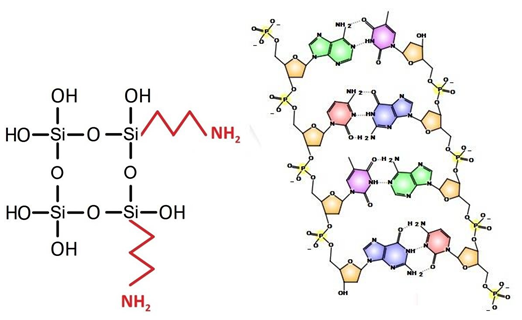
CHO cell transfected with NH2-silica NPs and pDNA complex (ORMOPLEXEs) expresses eGFP reporter protein upon the arrival to the nucleus.
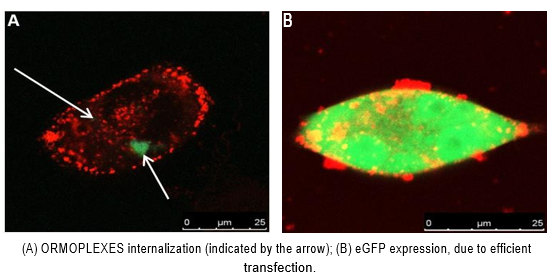
Zebrafish embryo microinjected with ORMOPLEXES shows no significant fluorescence (meaning that eGFP was not expressed and thus transfection to zebrafish cells did not occur at tested conditions). A too strong electrostatic interaction between the NH2-ORMOSIL NPs and the plasmid may hinder its dissociation from the carrier, retarding the plasmid transcription.
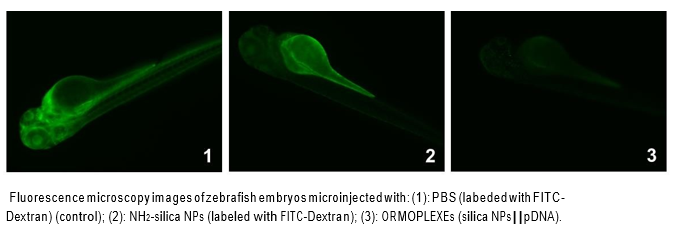
Superparamagnetic iron oxide NPs (SPIONs) emerge as the most promising contrast agents (CA) for magnetic resonance imaging (MRI). Despite the relevance of SPIONs in theranosis, SPIONs need to be coated with a biocompatible material able to: i) protect them against agglomeration, ii) hinder their surface activity, iii) provide chemical handles for further bioconjugation with drug molecules, targeting ligands, etc. and iv) limit non-specific SPIONs- cell interactions.

Silica arises as a prime choice for SPIONs coating: silica-coating increases SPIONs dispersion in aqueous liquid media and biologic fluids, prolonging blood circulation time, by screening the magnetic dipole attraction among the superparamagnetic cores, along with providing hydrophilic surface character.
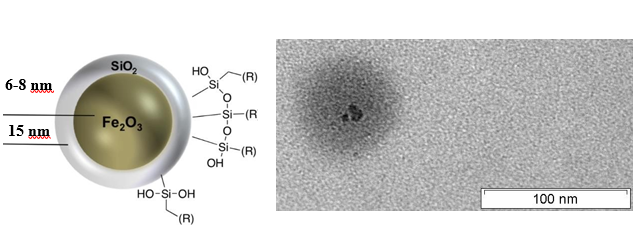
Super-paramagnetic iron oxide nanoparticles (SPIONs) have been reproducibly synthesized through precipitation techniques (in air) with different functional organic groups. r1/r2 ratios (recorded at 7T) are the highest observed yet.

MRI obtained of zebra-fishes injected with SPIONs-silica CA show high definition of anatomic structures.
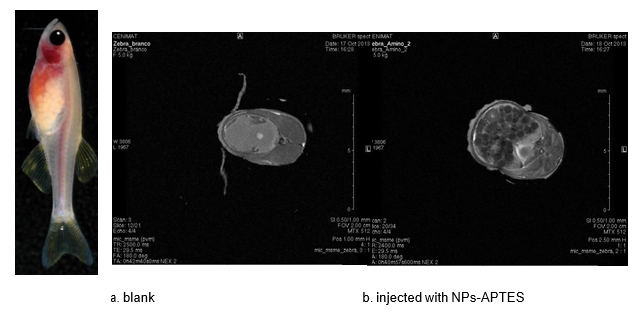
In clinic, for intravenous administration, there are already several pharmaceutical systems where drugs are encapsulated in liposomal structure. However, when oral administration is envisaged and gastrointestinal tract mucus and epithelium barrier need to be overcome, the protection of liposomes from anticipated disruption becomes a promising strategy. The emerging of silica-based drug delivery carriers for oral route administration was the leitmotiv for silica-coating of liposomes, LIPOSIL for short. Novel time-saving processes for liposomes’ coating were proposed, based on the classical Stöber protocol and on the modified LaMer method (which stands on a sharp nucleation process, induced by a strong liquid supersaturation). Only 2 hours are needed for the silica- coating step. In situ methyl and amine silica-functionalization were demonstrated. Silica grows on the charged liposome surfaces, forming a core-shell Liposil carrier (liposome- core// functionalized-silica-shell). Both anionic and cationic vesicles are proposed for the first time

The up-conversion (UpC) effect (which converts long-wavelength excitation light into short- wavelength emitted light) is a non-invasive in vivo imaging approach which allows the observation of living organisms.
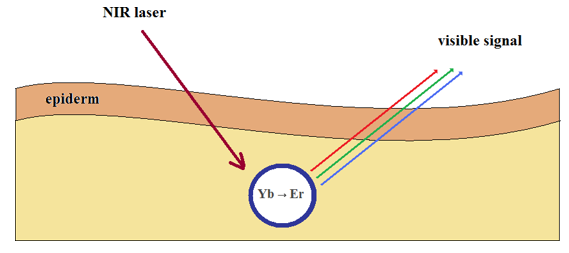
In the case of RE-doped silica materials the excitation radiation (in the near-infrared, NIR) falls within the optical transparency window of living cells and tissues (600-1300 nm), allowing maximum penetration depth, minimizing photo-damage and reducing tissue self-fluorescence. The output signal in the visible also allows direct identification of tumor areas due to abnormal tumor vasculature and optical imaging of living tissues.

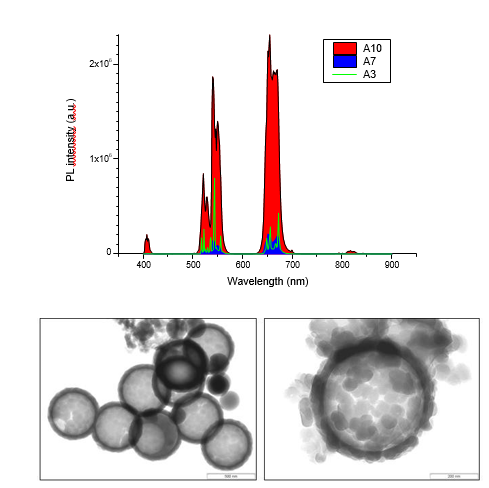
Enhancements of textiles by assembling nanostructured fibers and/or by chemically modifying their surface are different routes to achieve high-tech performance. The introduction of colloidal particles into textile matrices is one way to bring about this chemical surface modification. A green versatile platform (vector/carrier) able to be loaded with drugs/chemicals/therapeutic molecules and to be bound to multiple textile matrices (from cotton to polyester) was developed. The eco-friendly ammonia-free sol-gel protocol developed by the authors for the synthesis of Greensilica® particles allows an easy scalable incorporation in textile process, namely in unit operations like finishing, coating or dyeing. Being ammonia-free, the colloidal suspension will not bring any hazard problems to workers during impregnation step.


Designed and developed by: Diogo Reis